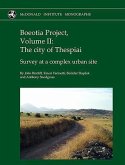This volume is the second in a series of five on the Insula (city block) of the Menander at Pompeii. The first (on the structures) and the fourth (on the silver treasure) have already been published; the third (on the objects) and the fifth (on the graffiti) are in preparation. The Insula of the Menander, approximately 3500 sq. m. in area, derives its name from the House of the Menander, one of the best-known dwellings of the ancient city. This was evidently the property of one of Pompeii's leading citizens. Renowned for its architectural grandeur and for the hoard of 110 pieces of silver plate found in a cellar, it also yielded room upon room of splendid wall-paintings and mosaic pavements, ranging in date from the first century BC to the eve of the eruption of AD 79. In addition to this dominant house, the block contains several smaller houses--notably the House of the Lovers and the House of the Craftsman--most of which contain further paintings and pavements of interest. The present volume publishes these decorations in full for the first time. Its importance lies in the fact that it covers the whole block, rather than concentrating upon isolated houses (as most previous volumes have done). This enables the reader not only to look at questions of chronology and iconography room by room and house by house, but also to observe broad patterns of taste and social differentiation within a particular neighborhood of Pompeii.
Hinweis: Dieser Artikel kann nur an eine deutsche Lieferadresse ausgeliefert werden.
Hinweis: Dieser Artikel kann nur an eine deutsche Lieferadresse ausgeliefert werden.







